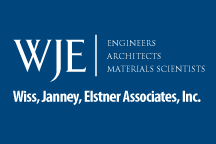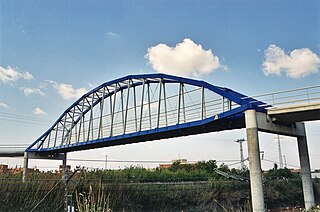Related Research Articles

Reinforced concrete, also called ferroconcrete, is a composite material in which concrete's relatively low tensile strength and ductility are compensated for by the inclusion of reinforcement having higher tensile strength or ductility. The reinforcement is usually, though not necessarily, steel bars (rebar) and is usually embedded passively in the concrete before the concrete sets. However, post-tensioning is also employed as a technique to reinforce the concrete. In terms of volume used annually, it is one of the most common engineering materials. In corrosion engineering terms, when designed correctly, the alkalinity of the concrete protects the steel rebar from corrosion.

Seismic retrofitting is the modification of existing structures to make them more resistant to seismic activity, ground motion, or soil failure due to earthquakes. With better understanding of seismic demand on structures and with recent experiences with large earthquakes near urban centers, the need of seismic retrofitting is well acknowledged. Prior to the introduction of modern seismic codes in the late 1960s for developed countries and late 1970s for many other parts of the world, many structures were designed without adequate detailing and reinforcement for seismic protection. In view of the imminent problem, various research work has been carried out. State-of-the-art technical guidelines for seismic assessment, retrofit and rehabilitation have been published around the world – such as the ASCE-SEI 41 and the New Zealand Society for Earthquake Engineering (NZSEE)'s guidelines. These codes must be regularly updated; the 1994 Northridge earthquake brought to light the brittleness of welded steel frames, for example.
Fibre-reinforced plastic is a composite material made of a polymer matrix reinforced with fibres. The fibres are usually glass, carbon, aramid, or basalt. Rarely, other fibres such as paper, wood, boron, or asbestos have been used. The polymer is usually an epoxy, vinyl ester, or polyester thermosetting plastic, though phenol formaldehyde resins are still in use.
Engineered Cementitious Composite (ECC), also called Strain Hardening Cement-based Composites (SHCC) or more popularly as bendable concrete, is an easily molded mortar-based composite reinforced with specially selected short random fibers, usually polymer fibers. Unlike regular concrete, ECC has a tensile strain capacity in the range of 3–7%, compared to 0.01% for ordinary portland cement (OPC) paste, mortar or concrete. ECC therefore acts more like a ductile metal material rather than a brittle glass material, leading to a wide variety of applications.
This is an alphabetical list of articles pertaining specifically to structural engineering. For a broad overview of engineering, please see List of engineering topics. For biographies please see List of engineers.

The Engineering News-Record is an American weekly magazine that provides news, analysis, data and opinion for the construction industry worldwide. It is widely regarded as one of the construction industry's most authoritative publications and is considered by many to be the "bible" of the industry. It is owned by BNP Media.
Fiber-reinforced concrete or fibre-reinforced concrete (FRC) is concrete containing fibrous material which increases its structural integrity. It contains short discrete fibers that are uniformly distributed and randomly oriented. Fibers include steel fibers, glass fibers, synthetic fibers and natural fibers – each of which lend varying properties to the concrete. In addition, the character of fiber-reinforced concrete changes with varying concretes, fiber materials, geometries, distribution, orientation, and densities.
Jean Muller was a French bridge engineer who focused on design and construction of concrete bridges.
Composite construction is a generic term to describe any building construction involving multiple dissimilar materials. Composite construction is often used in building aircraft, watercraft, and building construction. There are several reasons to use composite materials including increased strength, aesthetics, and environmental sustainability.

Wiss, Janney, Elstner Associates, Inc. (WJE) is an American corporation of architects, engineers, and materials scientists specializing in the investigation, analysis, testing, and design of repairs for historic and contemporary buildings and structures. Founded in 1956, WJE is headquartered in Northbrook, Illinois, and has over 600 professionals in twenty offices across the United States. WJE personnel are specialized in architectural, structural, and civil engineering; materials conservation, chemistry and petrography, and testing and instrumentation.

A deck is the surface of a bridge. A structural element of its superstructure, it may be constructed of concrete, steel, open grating, or wood. Sometimes the deck is covered by a railroad bed and track, asphalt concrete, or other form of pavement for ease of vehicle crossing. A concrete deck may be an integral part of the bridge structure or it may be supported with I-beams or steel girders.
The High Road Bridge is a road bridge over Long Run Creek in Lockport Township, Illinois. It is the world's first road bridge built using the hybrid composite beams (HCB's) invented by John R. Hillman and developed by the HC Bridge Company LLC. The HCB's are stronger, lighter and more corrosion resistant than the traditional concrete or steel beams. The HCB beam with a life span of 80 to 100 years and with minimal or no maintenance to the bridge girders is a cost competitive alternative to steel and concrete beam.

The FRP Pedestrian Bridge or Passarel·la de la Ciutat Jardí in Lleida, Spain is the longest arch bridge made out of standard GFRP pultruded profiles.

The Phyllis J. Tilley Memorial Bridge is a pedestrian bridge in Fort Worth, Texas. It was named in honor of Phyllis Tilley, who founded the Streams & Valleys non-profit organization dedicated to the preservation of the Trinity River.
PEDELTA is an independent multinational consultant firm headquartered in Barcelona, Spain which provides worldwide bridge and structural engineering services. The company is present in Canada, Colombia, Panama, Peru, Spain and the USA. The firm is internationally recognized by the introduction of advanced materials on bridges such as Cala Galdana Bridge, the first duplex stainless steel bridge, the GFRP Lleida Pedestrian Bridge, its innovative bridge aesthetics such as the Abetxuko Bridge and other cable supported structures.

The Advanced Structures and Composites Center is an independent research unit at the University of Maine that provides research, education, and economic development encompassing material sciences, manufacturing and engineering of composites and structures.

Nemkumar Banthia FRSC, is an Indian-born Canadian engineer and professor of civil engineering at the University of British Columbia and the CEO of IC-IMPACTS. He is best known for his research in the fields of cement-based and polymer-based fiber reinforced composites, particularly on testing and standardization, fracture behavior, strain-rate effects, durability and development of sustainable materials.
Abdeldjelil "DJ" Belarbi is an Algerian-American structural engineer and researcher whose research deals with the design, evaluation, and rehabilitation of reinforced and prestressed concrete bridges and buildings. He is currently the Hugh Roy and Lillie Cranz Cullen Distinguished Professor at University of Houston and previously a Distinguished Professor of Civil Engineering at Missouri University of Science and Technology.
Pedram Sadeghian is an associate professor in the Civil Engineering Department at Dalhousie University in Halifax, Nova Scotia, Canada. He is also a Tier 2 Canada Research Chair in Sustainable Infrastructure.
The reinforcement of 3D printed concrete is a mechanism where the ductility and tensile strength of printed concrete are improved using various reinforcing techniques, including reinforcing bars, meshes, fibers, or cables. The reinforcement of 3D printed concrete is important for the large-scale use of the new technology, like in the case of ordinary concrete. With a multitude of additive manufacturing application in the concrete construction industry—specifically the use of additively constructed concrete in the manufacture of structural concrete elements—the reinforcement and anchorage technologies vary significantly. Even for non-structural elements, the use of non-structural reinforcement such as fiber reinforcement is not uncommon. The lack of formwork in most 3D printed concrete makes the installation of reinforcement complicated. Early phases of research in concrete 3D printing primarily focused on developing the material technologies of the cementitious/concrete mixes. These causes combined with the non-existence of codal provisions on reinforcement and anchorage for printed elements speak for the limited awareness and the usage of the various reinforcement techniques in additive manufacturing. The material extrusion-based printing of concrete is currently favorable both in terms of availability of technology and of the cost-effectiveness. Therefore, most of the reinforcement techniques developed or currently under development are suitable to the extrusion-based 3D printing technology.
References
- ↑ "Bridge Engineer Wins ENR Award" (Flash video). Engineering News-Record . New York.
- 1 2 3 Cho, Aileen (April 12, 2010). "Award of Excellence Winner 2010 John Hillman". Engineering News-Record . 264 (11). New York: McGraw-Hill: 34–41. ISSN 0891-9526. Archived from the original on April 12, 2010. page 2 [ dead link ]; page 3 [ dead link ]; page 4 [ dead link ]; page 5 [ dead link ]; page 6 [ dead link ]
- ↑ Moen, Estela (January 19, 2010). "John R. Hillman (MSCE '90) recognized as ENR Top 25 Newsmaker of 2009". Virginia Tech Department of Civil and Environmental Engineering. Archived from the original on March 26, 2010.
- ↑ 2007 Invent Now Challenge, National Inventors Hall of Fame.
- ↑ 2007 Modern Marvel of the Year Announced Archived 2011-07-25 at the Wayback Machine , American Society of Civil Engineers.